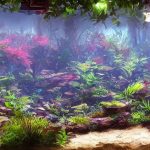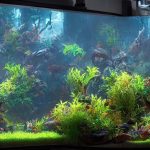Having an aquarium can be a fun and rewarding hobby, that requires some maintenance to ensure the health of your fish. One of the most important parts of maintaining an aquarium is setting up a filter. Filters help keep the water clean and healthy for your fish, so it’s essential to set up one correctly. In this article, we will provide step-by-step instructions on how to set up a fish tank filter.

Easy Or Difficult: Setting Up a Fish Tank Filter
Setting up a fish tank filter can be both easy and difficult depending on the type of filter you have.
If you are using an external canister filter, it will require some initial setup that may be more complicated than other filters. You’ll need to connect the intake and outflow tubes, fill the canister with media, prime the system, and adjust the flow rate. This process may require some patience and research but overall is not too difficult if you follow the instructions properly.
On the other hand, internal filters are generally much easier to set up as they come preassembled and simply need to be placed in the tank. All you need to do is attach a tube from the filter to an air pump or powerhead for circulation and then plug it in. You may also need to adjust the flow rate depending on your tank size, but this is usually very straightforward.
Types of Fish Tank Filters
There are five main fish tank filters: mechanical, biological, chemical, wet/dry, and canister.
Mechanical filters trap solid waste in a filter pad or sponge. They are the most basic type of filter, but they do not remove dissolved substances from the water.
Biological filters use beneficial bacteria. It’s to break down ammonia and nitrite into harmless nitrates. These bacteria live in the filter media or on surfaces within the tank.
Chemical filters absorb toxins from the water using activated carbon or resins. They can also help to remove odors and discoloration from the water.
Wet/dry filters combine mechanical and biological filtration. It’s circulating water through a series of trays. Those trays are filled with filter media and beneficial bacteria colonies.
Canister filters are external units that can be used for all types of filtration.
Preparation: Supplies Needed
When setting up a fish tank filter, there are certain supplies that need to be gathered before beginning.
First, assemble the necessary parts of the filter according to the manufacturer’s instructions. This often includes things. Such as filter media, an intake tube, and a pump.
Next, biological and chemical filtration media should be obtained for use in the tank. This will help keep the water clean and clear by removing harmful substances from it.
Finally, any other accessories desired for the aquarium should also be acquired and installed. These may include decorations, plants, or even an air pump or heater. It’s depending on what type of fish are being kept in the aquarium. All of these items will provide an optimal environment for healthy fish growth and maintenance of water quality within the tank.
Step 1: Placement Considerations
When it comes to the placement of your fish tank filter, there are a few key considerations. Firstly, you should make sure the filter is placed so that water is not splashing out of the tank and making a mess.
Secondly, you should ensure that the filter is creating enough water flow within the aquarium. It’s to keep everything circulating properly. Ideally, this should be done by positioning the intake tube near the bottom of one side. And should be orienting it across to the other side of the tank in an outward direction.
Finally, you should always have easy access to both cleaning and installing your filter. Then maintenance can be carried out quickly and easily.
Step 2: Cleaning the Fish Tank Filter
Once you have removed the filter from its housing, it is important to take time to thoroughly clean it. The first step is to rinse the filter media in room-temperature water. This will help remove debris and dirt particles that may have become trapped inside the filter. You should also replace any of the filter’s media that looks worn or damaged.
After rinsing off the filter media, place it back into its housing and attach all plugs and seals, making sure they are secure.
Finally, run a few gallons of dechlorinated water through the filter. Do it before attaching your fish tank to ensure maximum efficiency. If done correctly, this simple cleaning process should work. It’ll keep your fish tank’s filtration system running efficiently for years to come!
Step 3: Connecting Pipes and Hoses
Once all of the pieces are in place, it’s time to connect the pipes and hoses.
- Start by connecting the intake pipe from the filter to the back of the tank.
- Use a hose clamp to secure it in place. Then attach one end of an elbow fitting onto the other end of this pipe and run it over or around your filter box so that it is pointing down towards one side.
- Attach a length of flexible tubing onto the other end of this fitting, making sure that you use enough tubing. Then you can easily move your filter box around without straining any connections.
- Connect another length of flexible tubing onto this, ensuring that you have enough slack for easy maneuvering later on.
- Finally, attach a hose clamp to secure everything in place before connecting this tube to an open port on your filter box or motorized pump system.
Step 4: Adding Substrate and Media
Once you have placed the filter in the fish tank, it is important to add substrate and media. Substrate refers to the material on the bottom of your tank that can vary from gravel to sand. This will provide a base for beneficial bacteria growth while also allowing your aquatic animals to search for food and hide.
Media is additional material, such as foam or sponges. They are often used in conjunction with filters. These can be added directly into the filter, or they may need to be placed into a separate bag before being inserted. Make sure these materials are thoroughly rinsed before adding them to your aquarium. As dirt or debris could affect water quality.
Additionally, try not to disturb any existing beneficial bacteria living on surfaces by cleaning too much or changing out components too often; this could throw off the balance of your ecosystem.
Step 5: Power up the New Fish Tank Filter
Once the new filter is in place and attached to all necessary hoses, you are ready to power up your tank. Make sure the electrical outlet is working and then plug the pump into it. Turn on the switch located at the back of the filter.
Now check all connections for any leaks or loose parts that may need tightening. If everything looks good, turn on your heater as well to ensure all components are functioning correctly.
Finally, wait for a few minutes before turning on any other equipment. Such as lights or air pumps to give each part-time to adjust and begin filtering correctly.
Step 6: Cycling the Tank to Do a Long-term Test
After the tank has been set up, you should start to cycle the tank. Cycling involves introducing beneficial bacteria into the aquarium over time to help break down waste products and maintain a healthy environment for your fish. To do this, add small amounts of food or ammonia-based products (such as Fish Tank Ammonia) and observe the water parameters regularly. This process can take anywhere from two weeks to a month to complete.
After cycling is finished, it’s important to do a long-term test before adding any fish into the tank. This test will check for nitrates, nitrites, ammonia levels, and pH levels. It’s to make sure these parameters are at safe levels before introducing any livestock into your aquarium.
It’s best to wait at least one week after completing your cycling process. It is for all of these parameters to stabilize before testing them again. And potentially introducing any fish. Once everything is stable, you’ll be ready for stocking up your new aquarium with beautiful fish!
Conclusion: Set Up Complete
Setting up the fish tank filter is a vital step in creating an ideal environment for your fish. It’s important to follow the manufacturer’s instructions. It should take no more than 30 minutes to properly set up a fish tank filter.
Once the assembly and installation have been completed, it’s important to turn on the filter and check for any leaks or other issues. After ensuring that everything is running smoothly, prime the filter with water. And add beneficial bacteria before adding fish into your tank. By following these steps, you can be confident that you have created a safe space for your aquatic pets!




